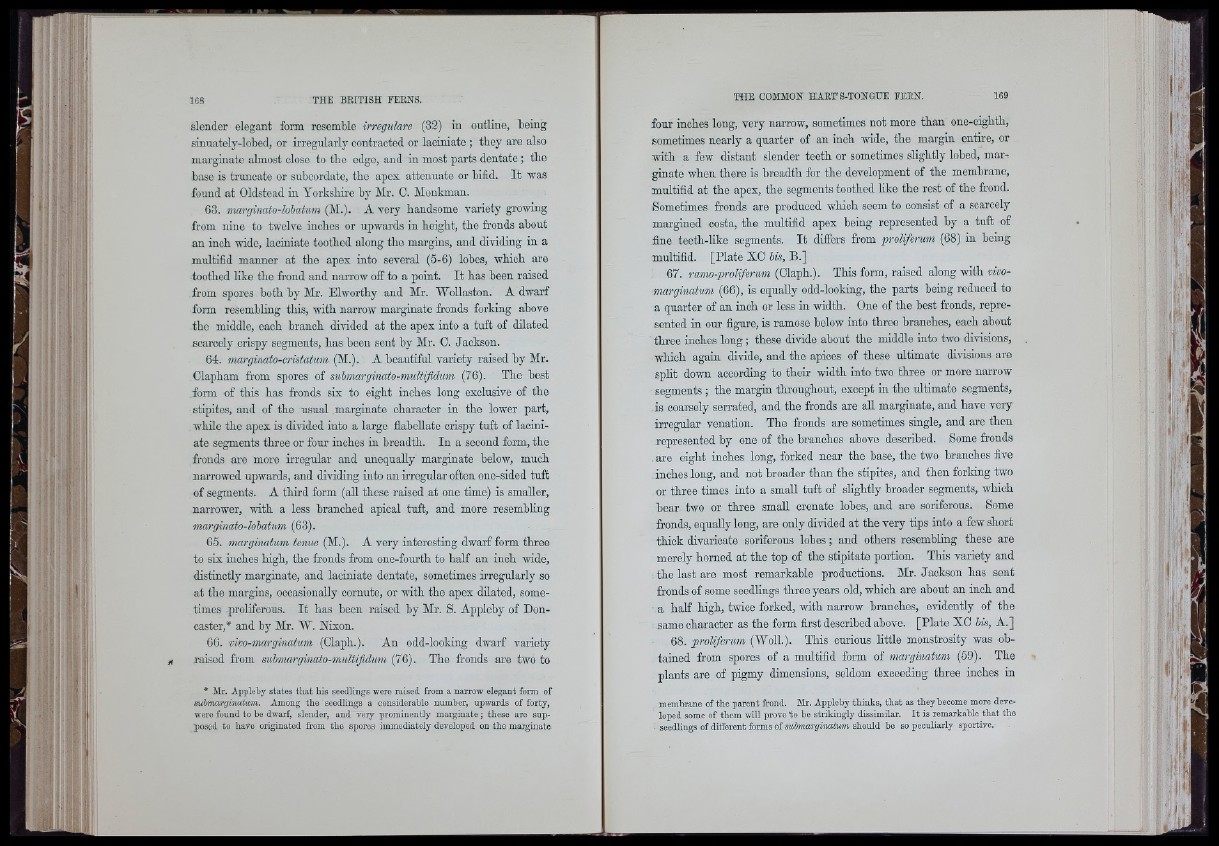
168
slender elegant form resemble irreguläre (32) in outline, being
sinnately-lobcd, or irregularly contracted or laoiniate ; they are also
marginate almost close to tho edge, aud in most parts dentate ; the
base is truncate or subcordate, tho apex attenuate or bifid. It was
found at Oldstead in Yorkshii'o by Air. C. Alonkman.
C3. marginato-lohahm (AI.). Avery handsome variety growing
from nine to twelve inches or upwards in height, the fronds about
an inch wide, laciniate toothed along tho margins, and dividing in a
multifid manner at tho apex into several (5-6) lobes, which are
toothed like the frond and narrow off to a point. It has been raised
from spores both by Air. Elwortby and Air. AVollaston. A dwarf
form resembling this, with narrow marginate fronds forking above
tho middle, each branch divided at the apex into a tuft of dilated
scarcely crispy segments, has been sent by Air. C. Jackson.
64. marginato-cristatum (AI.). A beautiful variety raised by Air.
Clapham from spores of suhmarginato-multifidmn (76). The best
form of this has fronds six to eight inches long exclusive of the
stipites, and of the usual marginate character in the lower part,
while the apex is divided into a largo flaboUate crispy tuft of laciniate
segments three or four inches in breadth. In a second form, the
fronds are more irregular and unequally marginate below, much
narrowed upwards, and dividing into an irregular often one-sided tuft
of segments. A third form (aU these raised at one time) is smaller,
narrower, with a less branched apical tuft, and moro resembling
marginato-lohatum (63).
65. marginatum tenue (AI.). A very interesting dwarf form three
to six inches high, the fronds from one-fourth to half an inch wide,
distinctly marginate, and laoiniate dentate, sometimes irregularly so
at the margins, occasionaUy cornute, or with the apex dilated, sometimes
.proHferous. It has been raised by Air. S. Appleby of Doncaster,*
and by Air. AV. Nixon.
66. vivo-marginatim (Claph.). An odd-looking dwarf variety
raised from suhmarginato-muUifidutn (76). The fronds are two to
* Mr. Appleby states tb a t his seedlings were raised from a narrow elegant form of
svimarginatum. Among th e seedlings a considerable number, upwards of forty,
were found to be dwarf, slender, and veiy prominently marginate ; these are supposed
to have originated from tb e spores immediately developed on tb e marginate
four inches long, very narrow, sometimes not more than one-eighth,
sometimes nearly a quarter of an inch wide, the margin entire, or
with a few distant slender tooth or sometimes slightly lobed, marginate
when there is breadth for tho development of the membrane,
multifid at the apex, the segments toothed like tho rest of tho frond.
Sometimes fronds are produced which seem to consist of a scarcely
margined costa, the multifid apex being represented by a tuft of
fine tooth-like segments. It differs from proliferum (68) in being
multifid. [Plate XO bis, B.]
67. ramo-proliferum (Claph.). This form, raised along with vivo-
marginatum (66), is equally odd-looking, the parts being reduced to
a quarter of an inch or less in width. One of the best fronds, represented
in our figure, is ramose below into throe branches, each about
three inches long ; these divide about the middle into two divisions,
which again divide, and the apices of these ultimate divisions are
split down according to their width into two three or more narrow
segments ; the margin throughout, except in the ultimate segments,
is coarsely serrated, and the fronds are aU marginate, and have very
irregular venation. The fronds are sometimes single, and are then
represented by one of the branches above described. Some fronds
are eight inches long, forked near the base, tho two branches five
inches long, and not broader than the stipites, and then forking two
or three times into a small tuft of slightly broader segments, which
bear two or three smaU crenate lobes, and are soriferous. Some
fronds, equaUy long, are only divided at tbe very tips into a few short
thick divaricate soriferous lohes ; and others resembling these are
merely horned at the top of the stipitate portion. This variety and
the last are most remarkable productions. Air. Jackson has sent
fronds of some seedlings three years old, which are about an inch and
a half high, twice forked, with narrow branches, evidently of the
same character as the form first described above. [Plate XC bis. A.]
68. proliferum (AVolL). This curious little monstrosity was obtained
from spores of a multifid form of marginatum (59). The
plants are of pigmy dimensions, seldom exceeding three inches in
memlirane of th e p a ren t frond. Mr. Appleby th in k s, th a t as theyhecome more developed
some of th em will prove to he strikingly dissimilar. I t is remarkaUe th a t the
5 of different forms of submarginatum, should be so peculiarly sportive.
I. !l
I ,
;i > !
11
Í